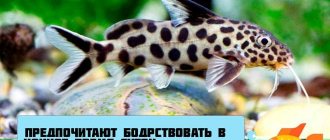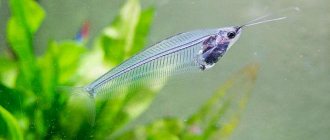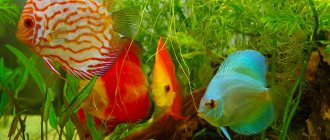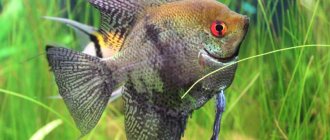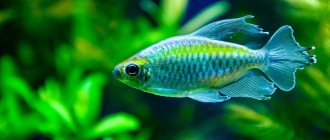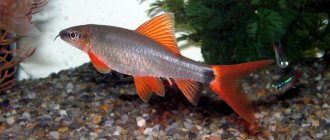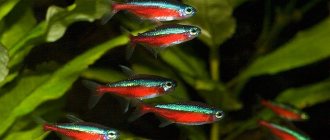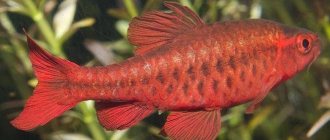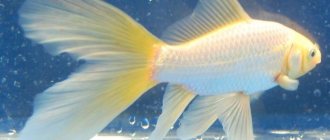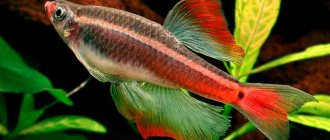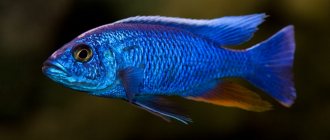Synodontis Eupterus or Veiled Synodontis (Synodontis eupterus) Boulenger / Boulenger, 1901
The name comes from the Greek word "Syno" meaning "close" and "odontis" meaning "tooth" - referring to the teeth of the fish's lower jaw, which are located close together. The second attribute in the name "Eupterus", which means "Beautiful Wings" in Greek, refers to its dorsal fin.
The feature that makes this catfish unique is its dorsal fin, which resembles a moving fan.
Habitat in nature
Synodontis eupterus was first described in 1901. Inhabits most of Central Africa, Nigeria, Chad, Sudan, Ghana, Niger, Mali. Found in the White Nile, Volta and Niger, as well as in the Chad basin.
Since the species is widespread, it is not a protected species. In nature, synodontis lives in rivers with muddy or rocky bottoms, feeding on insect larvae and algae.
They prefer rivers with medium currents. Like most catfish, they are omnivores and eat everything they can get their hands on. In nature, they often live in small flocks.
Reviews
Most aquarists and catfish breeders note their quiet and peaceful character. Fish coexist seamlessly with all types of fish. Breeders love to watch the strange and unusual antics of the aquatic pet. Because of this, catfish are so popular.
Description
Veiled synodontis is a fairly large fish, can reach 30 cm in length, but is usually smaller - 15-20 cm. The average life expectancy is about 10 years, although there is information about 25 years.
Veiled synodontis is called for its luxurious fins. It is especially distinguished by its dorsal fin, which in adult specimens ends in sharp spines. Large and flexible whiskers help to search for food among stones and silt. Body color is brown with randomly scattered dark spots. Juveniles and adults differ significantly in appearance, and juveniles do not have spines on their dorsal fin.
At the same time, juveniles can easily be confused with a related species - the catfish changeling. But when the veiled one grows up, it is no longer possible to confuse them. The main differences are their much larger size and longer fins.
As a defense, these catfish can make sounds that serve to scare away enemies.
At the same time, they expose their fins, covered with spines, and turn into difficult prey. But it is precisely this habit that makes them quite difficult to transplant; they get confused in the net. It is better to catch them using a container.
Nutrition
The basis of the diet of ancistrus is plant food. Vegetables, greens, such as: lettuce and cabbage leaves; green cucumbers, zucchini, pumpkin. Dry food can also be given: tablets and flakes. Tubifex and bloodworms are recommended as supplementary food.
Algal growths on the walls and decorations of the aquarium, as well as on the leaves of living plants, are also a food source for catfish of this species.
It is important to understand that if they are given little food, then ancistrus eat the young leaves of aquarium plants with great appetite.
CORRIDORAS: DESCRIPTION, TYPES, COMPATIBILITY, CONTENTS.
CHOPLOSTERNUM THORACATUM: DESCRIPTION AND CONTENTS.
HACA OR FROGMOUTH (CHACA CHACA)
Content complexity
It can easily be called an unpretentious fish. Adapts to different conditions, types of food and neighbors. Suitable for beginners, as it will forgive many mistakes, although it is better to keep it separately or with large species (don't forget about the size!).
Although it is not recommended to keep it in such conditions, it can live in extremely dirty aquariums and still be similar to the environment it lives in in the wild. Veiled synodontis needs only one thing - a spacious aquarium of 200 liters or more.
Male and female Synodontis eupterus
Females are usually larger than males and have a larger body girth.
Pictured is a female (left, vickisaquaticplace.com) and male (right) Eupterus, Synodontis eupterus
Adult females are usually plumper than males. Their bellies often reach impressive sizes. They can also be identified by examining the genital papilla. However, this method is not suitable for beginners. The fish is turned over onto its back and the dorsal fin is pinched between the middle and ring fingers. The genital area is located below the ventral fins. It becomes visible when the caudal fin is carefully pulled out. The male has an elongated, comb-like, pointed papilla. The female's papilla is rounded.
This method can be used to determine the sex of most medium and large species of the genus Synodontis. However, most species reach sexual maturity after 2 or more years.
Feeding
Omnivorous, feeds on insect larvae, algae, fry and any other food that it can find in nature. In an aquarium, feeding him is not a problem at all.
They will eagerly eat any food you offer them. Although they prefer to hide in shelters during the day, the smell of food will lure any synodontis.
Live, frozen, tablet food, everything suits him. Shrimp meat and bloodworms (both live and frozen) and even small worms are his favorite food.
What to feed the veiled ancistrus dragonfly
Photo: Sucker catfish, albino ancistrus veil “dragonfly”, in an aquarium on a snag.
Veiled ancistrus dragonflies need to be fed variedly. Their main food is plant matter, which should account for 60% of the total food volume for these fish. In addition to the algae that the fish themselves find in the tank, you need to give them fresh cucumber and zucchini, boiled lettuce and cabbage. Also, the diet of ancistrus should include live food (tubifex, bloodworms), and complex dry supplements containing plant components.
Fish are most active at dusk. But even at this time, the males do not move very far from the shelter they occupy. They protect their territory, driving away all possible contenders for it. With sudden changes in atmospheric pressure, ancistrus also become very active. With good care, these fish live up to 6 years.
Start
Keeping in an aquarium
Veiled synodontis does not require special care for itself. Regular soil siphoning and 10-15% water change once a week is all he needs.
The minimum volume of the aquarium is 200 liters. These catfish love aquariums with plenty of hiding places, where they spend most of the day. Having chosen a place, they guard it from relatives and similar species. In addition to driftwood, pots and stones, you can use volcanic lava, tuff, and sandstone.
Plants can also serve as shelter, but they must be large and tough types, as the catfish can destroy everything in its path. The soil is better sandy or small pebbles, so that the cat does not damage its sensitive whiskers.
Synodontis eupterus is excellent for keeping in the lower layer of water. If you keep him alone, he will become very tame and domestic, especially active during feeding.
They get along well with large species, provided the aquarium is large enough and has plenty of hiding places. Each fish will find a secluded corner that it will consider its own.
Appearance
Synodontis eupterus is very popular due to its vitality and beautiful color. Synodontis, kept one at a time in aquariums, are very interesting to watch, especially during feeding. They are friendly towards their relatives, at least as long as there is enough space and shelter in the form of stones and branches in the aquarium. Each fish chooses a secluded corner somewhere under a log or in a recess and “declares” it as its territory. If the aquarium is well equipped and there are several representatives of the species in it, they often arrange games, chasing each other through tunnels and narrow passages between stones.
This species is very hardy. He feels great in an aquarium with a volume of about 200 liters. If you set up your aquarium correctly, you will not have problems with care, and the fish will respond well to other individuals.
Most other aquarium fish, both large and small, are comfortable with such a neighborhood, as long as they are not bottom-dwelling species and their food chains do not overlap. Small fish that feed on benthic organisms, such as Corydoras or Otocinclus, may be subject to aggression from Synodontis. At the same time, even aggressive African cichlids can become excellent companions for these attractive “bottom orderlies.”
— Tolerance to the aquarium environment: high — Recommended aquarist skill level: for beginners — Family: Mochocidae — Genus: Synodontis — Species: Synodontis eupterus
Compatibility
Veiled synodontis is not aggressive, but it cannot be called a peaceful fish, rather a quarrelsome one. It is unlikely that he will touch the average fish that swims in the middle layers, but small catfish can be attacked, and he will perceive the fish that he can swallow as food.
In addition, they are greedy for food, and slow or weak fish may simply not keep up with them.
Veiled fish, like all synodontis, prefer to live in schools, but they have a clear hierarchy based on the size of the fish. The most dominant male will occupy the best cover and eat the best food.
Fights within a school rarely lead to injury, but can cause stress and illness in weak fish. This species gets along well in the same aquarium with African cichlids.
Gets along with other species, if they do not feed from the bottom, like him, and are large enough that he cannot perceive them as food. For example, corydoras and otocinclus are already at risk, since they also feed from the bottom and are smaller in size than the veil.
Reproduction of eupterus catfish
Veiled synodontis cannot be bred in aquarium conditions, but it is bred in fish farms using hormonal drugs. Many young specimens on the aquarium market were obtained using this method. In nature, S. eupterus reproduces during the rainy season, when there are many microorganisms in the water. The eggs are scattered, and no one cares about the offspring.
Juvenile Synodontis eupterus (ill. Lesley, flickr.com)
Diseases
As already mentioned, this is a very strong fish. It tolerates different conditions well and has strong immunity. But at the same time, high levels of nitrates in the water should not be allowed, as this can cause the mustache to die off. It is recommended to keep nitrate levels below 20 ppm.
The best way to maintain healthy fish is a varied diet and a spacious aquarium. The closer to the natural environment, the lower the stress level and the higher the activity. And to avoid infectious diseases, you need to use quarantine.
CATFISH CATFISH
Type of synodontis - catfish changeling
Habitat: Zaire; Content difficulties: easy; Water parameters in the aquarium: t 24 - 27 C; pH 6.8 – 7.0; dH 10; Life expectancy: up to 10 years; Aquarium size: at least 50 l. 2-3 times more is better; Body length: males - up to 6 cm, females - up to 10 cm; Behavior: peaceful; Diet: omnivorous.
The body color of the fish is brown with small dark spots. The body is stocky, somewhat flattened on the sides. The back is more convex than the abdomen, the eyes are large, the mouth is lower with three pairs of antennae, the caudal fin is two-lobed. The dorsal fin is triangular in shape and has a powerful first ray. Large adipose fin. Individuals of this species spend a significant part of their time with their belly up. This feature gave rise to the name Synodontis nigriventris catfish-shifters. In their natural habitat, skinwalkers swim in large schools of thousands of individuals. Therefore, it is recommended to purchase at least three fish. This will allow you to observe the natural group behavior of the skinwalkers.
SYNODONTIS GAMBIENSIS GAMBIAN SYNODONTIS
Habitat: Western Africa; Content difficulties: easy; Body length: up to 30cm; Behavior: may be aggressive; Diet: omnivorous.
Fish of this variety are easy to identify by their monotonous gray color. The ventral side of the body and antennae are whitish. There are several vague dark stripes on the caudal fin.
SYNODONTIS OCELLIFER
Adviсe
- Keep 2–5 catfish.
- Set up a couple of covers.
- Don't overfeed catfish.
- Don't put them near small fish.
- Use only smooth primer without sharp corners.
Be sure to get these changeling fish. After all, in Japan there is special respect for catfish, because according to the Japanese legend about the structure of the world, the earth is located on the back of the great catfish Namazu.
Previous
FishDetailed instructions for keeping active barbus fish
Next
FishWhy do angelfish fight among themselves?
